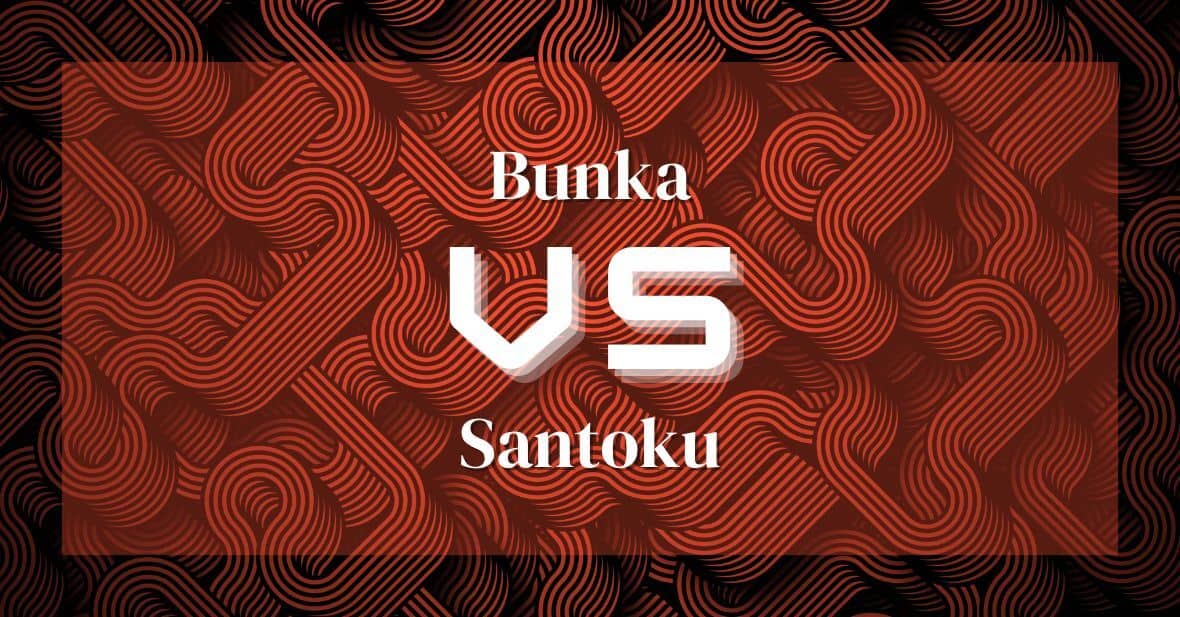Bunka vs Santoku: Two Japanese Knives, One Cutting Quest
Are you stuck between a bunka and a santoku? Don’t worry, it’s not an age-old riddle or a conundrum that needs solving. It’s just the choice of knives in your kitchen!
Bunka and santoku are two popular Japanese knives used for different purposes. To help you make the right decision, let’s dive into this ‘cutthroat’ comparison!
In this article, we’ll explore the differences in blade shapes, uses for each type of knife and how to choose the perfect one for you. So sharpen your knowledge and let’s get slicing!
Bunka vs Santoku: A Comparison
Comparing the two knives, the bunka has a curved blade whereas the santoku has a flatter one. The difference in their shapes is key to what makes them each unique when it comes to cutting, slicing, and chopping.
Bunka knives are crafted with grinding edges that make them well-suited for intricate cuts and detail work, like julienne vegetables or mincing herbs. They also excel at preparing fish fillets because of their tapered shape and sharpness.
On the other hand, santoku knives feature honing techniques that provide superior control to cut through tough ingredients such as meat or dense vegetables. This makes them ideal for larger tasks like dicing an onion or shredding cabbage in no time flat!
Both styles of knife offer great potential for home chefs who are looking to upgrade their cooking arsenal—it all just depends on your individual preferences and needs.
Blade Shapes
Investigating the shapes of blades can help us uncover a deeper understanding of how to best use each type of blade.
Bunka and santoku knives have distinct blade shapes that are designed for different purposes. The bunka knife has a curved, pointed tip and a flat edge that’s ideal for chopping vegetables, while the santoku knife has a straight edge with an angled tip that’s perfect for slicing meats.
Both types of knives require grinding techniques and honing processes to ensure they stay sharp and perform their best. Knowing which shape works best for your needs will help you get the most out of your kitchen tools!
Uses for the Bunka Knife
You’ll love using a bunka knife for its curved, pointed tip and flat edge – perfect for chopping vegetables quickly and easily! The sharp blade of the bunka knife is great for slicing, mincing, and dicing all types of food with ease. Not only is it great at cutting through vegetables quickly, but also meat and fish.
Plus, the design of the bunka allows you to sharpen more effectively since its shape makes it easier to create an even edge on both sides of the blade.
When using a bunka knife, make sure you’re using a proper cutting board made from wood or plastic so your valuable knives won’t become dulled over time. Additionally, remember to use various sharpening techniques such as honing and stropping every few months – this will keep your knife in top condition!
Finally, be sure to rinse off any residue on the blade after each use; this will help maintain its original sharpness.
Uses for the Santoku Knife
Try out a santoku knife for quick and easy chopping, slicing, mincing, and dicing – it’s the perfect tool for your kitchen!
With its signature flatter blade shape and rounded tip, this Japanese-style knife is specifically designed to make light work of food preparation. It slices through vegetables like butter – perfect for creating delicious stir fries or salads. And let’s not forget that it’s great for slicing thin cuts of meat too.
Plus, with careful sharpening techniques, you can keep your santoku in top condition so it keeps performing at its best. So why not give one a try? You won’t be disappointed with the results!
Choosing the Right Knife for Your Kitchen
Choosing the right knife for your kitchen is essential; it’s like choosing your partner in crime!
When selecting a new knife, there are many important factors to consider. First and foremost, consider the grinding techniques used to make the blade. Santoku knives typically have hollowed edges while bunka knives tend to have a single-beveled edge. These different techniques create distinct cutting styles, so you should choose one that suits your needs.
Additionally, factor in the type of material used for the blade itself such as stainless steel or high carbon steel. Both of these will provide sharpness and strength but vary greatly in terms of durability and maintenance requirements.
Ultimately, taking into account both grinding techniques and blade materials can help you find the perfect knife for your kitchen!
Conclusion
You’ve learned about the differences between a bunka and santoku knife. The shape of the blade, as well as their uses, are two factors to consider when choosing the right knife for your kitchen.
Ultimately, it depends on what you plan to do with it. As they say, “A tool is only as good as its user.” So take your time and find the knife that best suits your needs.
With practice and care, you’ll be slicing and dicing like a pro in no time!
Frequently Asked Questions
What Is The Best Overall Knife For A Home Kitchen?
When it comes to finding the best overall knife for a home kitchen, you have many options. But if you’re looking for something that can handle all your cooking techniques and meal prep needs, then a santoku is the way to go.
This Japanese-style knife has a wide blade with a curved edge that makes it perfect for slicing, dicing, and chopping. Plus, its lightweight design makes it easy to maneuver around your cutting board. And with its sharp blade and comfortable grip, you’ll be prepping meals like a pro in no time!
Are Santoku Knives Heavier Than Bunka Knives?
You’re standing in the kitchen, trying to decide which knife is best for you. You know that a santoku and bunka are both great options, but you can’t help but wonder: which one is heavier?
Well, let’s take a look at the blade construction and handle design of each. The santoku has a thinner blade than the bunka, making it lighter overall. However, its handle is usually made from wood or plastic, while the bunka’s handle is often made from metal – giving it more weight.
So if you’re looking for something light and easy to maneuver around your kitchen countertop, then go with the santoku! But if you want something with a bit more heft behind it, then opt for the bunka.
Can Bunka Knives Be Used For Cutting Meat?
Yes, bunka knives can be used for cutting meat! With the right cutting techniques and proper knife maintenance, you’ll be slicing through steaks like a pro in no time.
Bunka knives are designed with a curved blade that makes it easy to cut through tough meats without having to saw back and forth. Plus, they’re lightweight so you won’t get tired from holding them for long periods of time.
So go ahead and give your bunka knife a try – you’ll be glad you did!
How Should I Sharpen My Santoku Knife?
Sharpening your santoku knife is like training a wild horse: it takes finesse, patience, and skill.
To ensure optimal edge retention and hand grip comfort, try using one of the following sharpening techniques. Start by honing the blade with a whetstone or diamond stone to create an even surface. Then, use a honing steel to refine the burr on the edge of the blade.
If you’re looking for an easier solution, opt for an electric knife sharpener that will get the job done quickly and easily.
With regular maintenance and careful sharpening, your santoku knife can remain razor-sharp for years to come!
Is There A Difference In The Amount Of Effort Required To Cut Food With A Bunka Or Santoku Knife?
Cutting food with a bunka or santoku knife requires different amounts of effort depending on your slicing technique and the design of the blade.
Both styles feature a unique handle-to-blade ratio that makes them well suited for different types of slicing.
For example, the bunka’s curved blade is perfect for rocking motions while the santoku’s flat blade is ideal for chopping.
So if you’re looking to make light work in the kitchen, choose your knife wisely!
Additional Resources
19 Types of Kitchen Knives & Their Uses
Western Style Knives 101 | A Comprehensive Introduction to the Basics
The Art of the Slice: A Dive into Japanese Knife Types
Unveiling The Mystery: What Is A Santoku Knife Used For And Why You Need One
Forging Culinary Excellence: The Best Steel For Kitchen Knives

